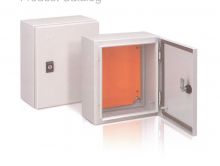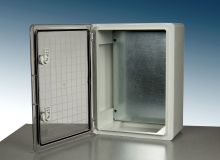
Devil is in the Detail - advice on selecting an enclosure
Andy Hatter of Hylec-APL offers advice on what to look for when selecting an enclosure – and why there’s more to consider than meets the eye
To think of enclosures as simple boxes is to underestimate their importance – the focus is so often on the function of the electrical or electronic installation inside that the enclosure itself is deemed of secondary importance and in some cases barely merits a fraction of the time and thought that has gone into the rest of the project. This is a strategy that is misguided at best and risky at worst, as the role of any electrical enclosure is not only to house but also to protect its contents. As electrical and electronic equipment is both vulnerable and vital to the overall correct functioning of an installation, the correct degree of protection from a whole range of hazards should be considered an integral part of any project. Hazards come in multiple guises, from environmental factors through mishaps and even vandalism. If such damage to electrical components occurs, equipment either ceases to function or has to be stopped for repair, with consequences ranging from lost production in an industrial situation, possible closure of parts of a facility and other undesirable and costly results. Any of these events will do little for the reputation of the system installer/builder, so are best avoided! Thankfully, there are numerous enclosures on the market and investing some time specifying requirements and researching the cost/benefit of models offered by various manufacturers will avoid these pitfalls.
Defining Requirements
It seems obvious, but a quick checklist to arrive at the correct specification needs to include:
Environmental factors: Interior or exterior installation? Protection needed against damp, rainwater, dust, sand, salt water, wind, dripping water, storms, extremes of temperature?
Strength and Combustibility: Accidental damage from falling objects and passing machinery – strength to withstand blows depends on the enclosure having an IK rating, ranging from a slight knock up to IK-10 which withstands an impact from a 5kg object impacting from a height of 40 cm. Does the enclosure need to be flame retardant?
Location: Protection from unauthorised access, accidental damage, electrical interference required?
Access: Physical inspection of contents or visual inspection required? A transparent door will aid the latter, save time and not disturb the installation.
Size: length, width, height when components are mounted on a back panel will give the minimum internal dimensions required. Don’t forget to add space for ease of maintenance or for any likely or planned future additional components. Space may need to be added to allow heat to dissipate. Externally, is there enough room for any external controls mounted onto the cover? Also are there restrictions – does the enclosure have to fit an existing footprint or given dimension?
Thermal Management: Consider the thermal properties of the enclosure itself - steel enclosures conduct heat, polycarbonate enclosures insulate somewhat. Extremes of either cold or heat can create moisture damage or shorten the useful life of components. Accessories including venting kits and exhaust fans can be used together with thermostats for thermal management – best check first what accessories are compatible and available for the selected enclosure.
Other factors: Often it is the hidden extras which add to overall cost! Consider if items such as locks and keys, mounting brackets, back plates are included or have to be budgeted as extras.
Polycarbonate, ABS or Steel?
Conventionally, enclosures are made of pressed steel, but recent years have seen the growing emergence of polycarbonate and ABS, which are now the preferred choice in many applications, including in the industrial arena where impact damage is possible. There are many types of polycarbonate and ABS. For instance, a flame retardant ABS, when used with a wall thickness up to 3.5mm, can provide impact resistance of IK08 (protection against impacts with an energy up to 5 Joules). Since ABS doesn’t rust, the enclosures are also able to offer protection from continual exposure to external conditions, even in dockside and marine applications. The DED Range from Hylec-APL, for example, is a range of hinged-door ABS enclosures that offer similar degrees of impact resistance to metal enclosures of similar sizes. Their advantages include lower unit costs and quicker installation; in use, they do not dent on impact, nor do they corrode in the presence of moisture or many chemicals. Hinged-door enclosures that are fitted with locks and seals as standard are extremely secure and reliable, even when installed outside, while the external mounting brackets can be designed to make installation simple without compromising the IP65 rating against dust and moisture ingress. High-quality seals and hinges ensure that performance won't deteriorate over time. The DED Range of hinged-door enclosures are available in a selection of eight sizes and can be specified with a solid grey ABS door or, a transparent polycarbonate one, which is popular in applications where a meter has to be read or other indicators checked.
The newer designs of steel enclosures also encompass many advantages, particularly for exterior applications. Hylec’s DEDS Series of lockable, solid door steel enclosures which launched this year are specifically designed to provide high-quality, secure, cost-effective protection for exterior electronic and electrical installations, such as industrial control, HVAC, lighting and automation, plus holiday home consumer units where protection against the elements and tampering are important considerations.
IP66 rated against water and dust ingress, they meet IK10 specifications against impact and comply with IEC 60529 standards. For superior robustness and longevity, DEDS enclosure housings are guaranteed against corrosion for three years and are fabricated from galvanised steel, powder-coated in grey RAL7035. DEDS Series enclosure back plates are manufactured from 2mm galvanised steel and carry a similar 3-year anti-corrosion warranty. All threaded studs are rust-proof stainless steel. As the DEDS Series is primarily designed with exterior installation in mind, the gland-plate modules for cable entry (which can be top or base mounted) are supplied with IP66-rated sealing gaskets for total protection against dust and water jets or waves. A pre-wired earth link on stainless steel studs between the door and the housing saves valuable installation time and cost. Supplied complete with metal lock and key plus galvanised wall mounting brackets, DEDS Series steel enclosures are available in fifteen different sizes, with a comprehensive range of available accessories, including cable glands, Kwik-Fix cable glands, venting elements, contactors/thermal overloads and fans.
As with so many things, with enclosures the devil is in the detail. Pitfalls include buying a steel door enclosure that isn’t galvanised – it can corrode within a year; often a supplied earth stud is mild steel, not stainless steel – it’s cheaper but can corrode; a steel door enclosure without the earth wire included means paying up to £2.50 for the earth wire, plus installation cost; plastic locks and keys on a steel door enclosure are cheap but far easier to break. The initial difference in price between the best products and the rest is often negligible. Quality and value for money are the same with the right enclosure choice.
ECN - January 2017
Latest News
-
02/01/2025
BCL Enclosures joins Hylec -
27/09/2024
Hylec Showing at EDS 2024 We are exhibiting at EDS... -
30/01/2024
Exciting New Appointments for Hylec Hylec Kickstarts... -
11/01/2024
Hylec Go Kart Grand Prix The line-up for the first... -
01/12/2023
Hylec Closing dates for Christmas Hylec-APL will be closed from... -
01/02/2023
Hylec introduces new, improved Debox SL Hylec introduces the...
01933 234400



